Ernest Thompson Seton
Ernest Thompson Seton (born Ernest Evan Thompson[1] August 14, 1860 – died October 23, 1946) was an author (published in the United Kingdom, Canada, and the US), wildlife artist, founder of the Woodcraft Indians in 1902 (renamed Woodcraft League of America) and one of the founding pioneers of the Boy Scouts of America (BSA) in 1910. Seton also influenced Lord Baden-Powell, the founder of one of the first Scouting organization. His notable books related to Scouting include The Birch Bark Roll and the Boy Scout Handbook. He is responsible for the appropriation and incorporation of what he believed to be American Indian elements into the traditions of the BSA.
Ernest Thompson Seton | |
|---|---|
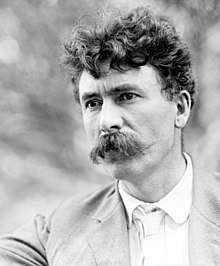 | |
| Born | August 14, 1860 South Shields, County Durham, England, United Kingdom |
| Died | October 23, 1946 (aged 86) Seton Village, New Mexico, United States |
| Other names | "Ernest Evan Thompson", "Ernest Seton-Thompson", "Black Wolf", "Chief" |
| Occupation | Author, wildlife artist |
| Known for | Founder of the Woodcraft Indians and founding pioneer of the Boy Scouts of America |
| Spouse(s) | Grace Gallatin Thompson Seton (Wife) Julia M Buttree Seton (Wife) |
| Children | Anya Seton (Daughter) Dee Barber Seton (Daughter) |
| Parent(s) | Joseph Logan Thompson (Father) Alice Snowdon Thompson (Mother) |
| Relatives | Pamela Cottier Seton (Granddaughter) Clemency Chase Seton (Granddaughter) Cottier Seton (Grandson) |
| Awards | John Burroughs Medal (1927) Daniel Giraud Elliot Medal (1928) Silver Buffalo Award |
Early life
Seton was born in South Shields, County Durham, England of Scottish parents. His family emigrated to Canada in 1866. Most of his childhood was spent in Toronto, Ontario and the family is known to have lived at 6 Aberdeen Avenue in Cabbagetown. As a youth, he retreated to the woods of the Don River to draw and study animals as a way of avoiding his abusive father. He won a scholarship in art to the Royal Academy in London, England.[2]
On his twenty-first birthday, Seton's father presented him with an invoice for all the expenses connected with his childhood and youth, including the fee charged by the doctor who delivered him. He paid the bill, but never spoke to his father again.[3][4]
In 1882, he joined his brother on a homestead outside Carberry, Manitoba, where he began to write. In 1891, he published The Birds of Manitoba and was appointed Provincial Naturalist by the government of Manitoba.[5] He continued to publish books about Manitoba for decades to come, including The Life Histories of Northern Animals: An Account of the Mammals of Manitoba and lived in Manitoba until 1930, when he moved to Sante Fe, New Mexico.
He changed his name to Ernest Thompson Seton (after initially changing it to Ernest Seton-Thompson"), believing that Seton had been an important family name. He became successful as a writer, artist and naturalist, and moved to New York City to further his career. Seton later lived at Wyndygoul,[6] an estate that he built in Cos Cob, a section of Greenwich, Connecticut. After experiencing vandalism by the local youth, Seton invited them to his estate for a weekend where he told them what he claimed were stories of the American Indians and of nature.[7]
He formed the Woodcraft Indians in 1902 and invited the local youth to join. Despite the name, the group was made up of non-native boys and girls. The stories became a series of articles written for the Ladies Home Journal, and were eventually collected in The Birch Bark Roll of the Woodcraft Indians in 1906. Shortly after, the Woodcraft Indians evolved into the Woodcraft Rangers, which was established as a non-profit organization for youth programming in 1922.
Since 1922, Woodcraft Rangers has served Los Angeles youth with Seton's model of character building, which encompasses service, truth, fortitude, and beauty. [8] Since then, Woodcraft Rangers youth have been received in a safe environment to encourage the discovery of their own talents. Today the Woodcraft Rangers organization serves over 15,000 youth in the Los Angeles county by helping them find pathways to purposeful lives. They offer expanded learning opportunities to youth from kindergarten to twelfth grade. Youth participants are encouraged to discover their natural talents and are embraced daily with the belief that all children are innately good.
Scouting
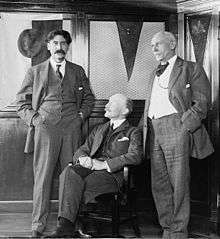
Seton met Scouting's founder, Lord Baden-Powell, in 1906. Baden-Powell had read Seton's book, The Birch Bark Roll of the Woodcraft Indians, and was greatly intrigued by it. The pair met and shared ideas. Baden-Powell went on to found the Scouting movement worldwide, and Seton became the president of the committee that founded the Boy Scouts of America (BSA) and was its first (and only) Chief Scout. Seton's Woodcraft Indians (a youth organization) combined with the early attempts at Scouting from the YMCA and other organizations and with Daniel Carter Beard's Sons of Daniel Boone, to form the BSA.[9] The work of Seton and Beard is in large part the basis of the Traditional Scouting movement.[10]
Seton served as Chief Scout of the BSA from 1910 to 1915 and his work is in large part responsible for the appropriation and incorporation of what he believed to be American Indian elements into the traditions of the BSA. However, he had significant personality and philosophical clashes with Beard and James E. West.
In addition to disputes about the content of Seton's contributions to the Boy Scout Handbook, conflicts also arose about the suffragist activities of his wife, Grace Gallatin Seton Thompson, and his British citizenship. The citizenship issue arose partly because of his high position within BSA, and the federal charter West was attempting to obtain for the BSA requiring its board members to be United States citizens. Seton drafted his written resignation on January 29, 1915 but did not send it to BSA until May.[11] The position of Chief Scout was eliminated and the position "Chief Scout Executive" was taken on by James West. In 1931 Seton became a United States citizen.
Personal life
Seton married twice. His first marriage was to Grace Gallatin in 1896. Their only daughter, Ann, was born in 1904 and died in 1990. Ann, who later changed her first name, became a best-selling author of historical and biographical novels as Anya Seton. According to Ann's introduction to the novel Green Darkness, Grace was a practicing Theosophist. Ernest and Grace divorced in 1935, and Ernest soon married Julia Moss Buttree. Julia wrote works by herself and with Ernest. They did not have any biological children, but in the 1930s they sought to adopt Moss Buttree's niece, Leila Moss, who lived with them for years in New Mexico.[12] In 1938, they adopted an infant daughter, Beulah (Dee) Seton (later Dee Seton Barber). Dee Seton Barber, a talented embroiderer of articles for synagogues such as Torah mantles, died in 2006.
Seton called his father, Joseph Logan Thompson, "the most selfish man I ever knew, or heard of, in history or in fiction." He cut off ties completely after being made to pay off an itemized list of all expenses he had cost his father, up to and including the doctor's fee for his delivery, a total of $537.50.[13]
Seton's parents lived out their lives in Toronto, as did all but two brothers, who moved to British Columbia.
Writing and later life

Seton was an early pioneer of the modern school of animal fiction writing, his most popular work being Wild Animals I Have Known (1898), which contains the story of his killing of the wolf Lobo. He later became involved in a literary debate known as the nature fakers controversy, after John Burroughs published an article in 1903 in the Atlantic Monthly attacking writers of sentimental animal stories. The controversy lasted for four years and included important American environmental and political figures of the day, including President Theodore Roosevelt.[14]
In 1907, Seton and the naturalist Edward Alexander Preble verified a claim from ten years earlier by the frontiersman Charles "Buffalo" Jones that Jones and his hunting party had shot and fended off a hungry wolf pack near the Great Slave Lake in Canada. Seton and Preble discovered the remains of the animals near Jones's long abandoned cabin.[15]
For his work, Lives of Game Animals, Volume 4, Seton was awarded the Daniel Giraud Elliot Medal from the National Academy of Sciences in 1928 .[16] In 1931, he became a United States citizen. Seton was associated with the Santa Fe arts and literary community during the mid-1930s and early 1940s, which comprised a group of artists and authors including author and artist Alfred Morang, sculptor and potter Clem Hull, painter Georgia O'Keeffe, painter Randall Davey, painter Raymond Jonson, leader of the Transcendental Painters Group, and artist Eliseo Rodriguez.[17] He was made a member of the Royal Canadian Academy of Arts.[18]
In 1933, Seton purchased 100 acres (0.4 km2) in Santa Fe County, New Mexico, United States. Seton ran training camps for youth leaders and had a small publisher named Seton Village Press that closed in 1943 due to World War II. The tract eventually grew to 2500 acres (10 km2). Seton Village was established as an unincorporated community.
Seton designed and built his castle as a 32-room, 6,900 square foot (640 m2) multi-level building with a flat-roof and rough hewn stone wall exterior. The interior had oak floors and plaster walls with the ceilings supported by log rafters. The Castle was built on a hill at an elevation of 7,000 feet (2100 m). It is designated a National Historic Landmark and a New Mexico State Cultural Property. The castle burned down while being restored in 2005. The Academy for the Love of Learning, which owns the property, has decided to preserve the castle ruins as a "contemplative garden."[19]
He died in Seton Village, New Mexico, at the age of 86. Seton was cremated in Albuquerque, New Mexico. In 1960, in honor of his 100th birthday and the 350th anniversary of Santa Fe, his daughter Dee and his grandson, Seton Cottier (son of Anya), scattered the ashes over Seton Village from an airplane.[20]
Legacy
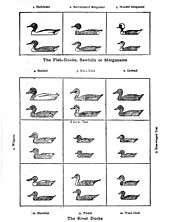
The Philmont Scout Ranch houses the Seton Memorial Library and Museum. Seton Castle in Santa Fe, built by Seton as his last residence, housed many of his other items. Seton Castle burned down in 2005 during an attempt at restoration, but all the artwork, manuscripts, books, etc., had been removed to storage before renovation was to have begun.[21]
The Academy for the Love of Learning, an educational organization in Santa Fe, acquired Seton Castle and its contents in 2003. The new Academy Center opened in 2011 includes a gallery and archives featuring artwork and other materials as part of its Seton Legacy Project. The Seton Legacy Project organized a major exhibition on Seton opening at the New Mexico History Museum on May 23, 2010, the catalog published as Ernest Thompson Seton: The Life and Legacy of an Artist and Conservationist by David L. Witt.
Roger Tory Peterson drew inspiration for his field guide from the simple diagram of ducks that Seton included in Two Little Savages.[22]
Several of Seton's works are written from the perspective of a predator and were an influence upon Robert T. Bakker's Raptor Red.[23]
Seton is honoured by the Ernest Thompson Seton Scout Reservation in Greenwich, CT, and with the E.T. Seton Park in Toronto, Ontario, Canada. Obtained in the early 1960s as the site of future Metro Toronto Zoo, the land was later used to establish parkland and home to the Ontario Science Centre. Seton is mentioned in Philip Roth's Novel, Nemesis, where he is credited for having introduced Indian lore to the American camping movement.[24] A plaque is found on the front wall of 6 Aberdeen Avenue in Toronto, where Seton had lived as a child.
Works
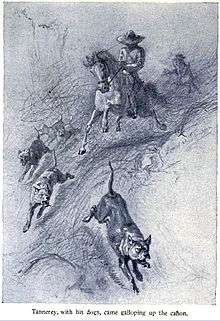
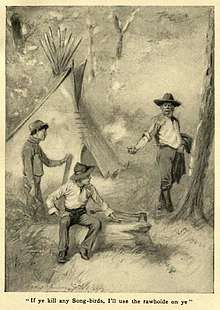
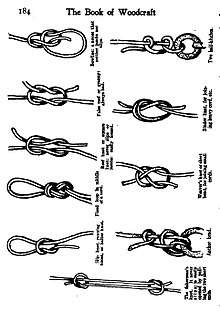
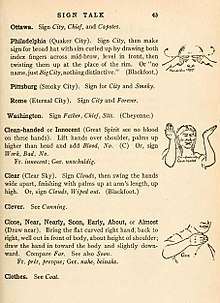
- Mammals of Manitoba (1886)
- Birds of Manitoba, Foster (1891)
- How to Catch Wolves (1894)
- Studies in the Art Anatomy of Animals (1896)
- Wild Animals I Have Known (1898)
- The Trail of the Sandhill Stag (1899)
- The Wild Animal Play for Children (Musical) (1900)
- The Biography of a Grizzly (1900)
- Tito: The Story of the Coyote That Learned How (1900)
- Bird Portraits (1901)
- Lives of the Hunted (1901)
- Twelve Pictures of Wild Animals (1901)
- Krag and Johnny Bear (1902)
- How to Play Indian (1903)
- Two Little Savages (1903)
- How to Make a Real Indian Teepee (1903)
- How Boys Can Form a Band of Indians (1903)
- The Red Book (1904)
- Monarch, The Big Bear of Tallac (1904)
- Woodmyth & Fable (1905)
- Animal Heroes (1905)
- The Birchbark Roll of the Woodcraft Indians (1906)
- The Natural History of the Ten Commandments (1907)
- Fauna of Manitoba, British Assoc. Handbook (1909)
- Biography of a Silver Fox (1909)
- Life-Histories of Northern Animals (2 volumes) (1909)
- Boy Scouts of America: Official Handbook, with General Sir Baden-Powell (1910)
- The Forester's Manual (1910)
- The Arctic Prairies (1911)
- Rolf in the Woods (1911)
- The Book of Woodcraft and Indian Lore (1912)
- The Red Lodge (1912)
- Wild Animals at Home (1913)
- The Slum Cat (1915)
- Legend of the White Reindeer (1915)
- The Manual of the Woodcraft Indians (1915)
- Wild Animal Ways (1916)
- Woodcraft Manual for Girls (1916)
- The Preacher of Cedar Mountain (1917)
- Woodcraft Manual for Boys; the Sixteenth Birch Bark Roll (1917)
- The Woodcraft Manual for Boys; the Seventeenth Birch Bark Roll (1918)
- The Woodcraft Manual for Girls; the Eighteenth Birch Bark Roll (1918)
- Sign Talk of the Indians (1918)
- The Laws and Honors of the Little Lodge of Woodcraft (1919)
- The Brownie Wigwam; The Rules of the Brownies (1921)
- The Buffalo Wind (1921)
- Woodland Tales (1921)
- The Book of Woodcraft (1921)
- The Book of Woodcraft and Indian Lore (1922)
- Bannertail: The Story of a Gray Squirrel (1922)
- Manual of the Brownies 6th edition (1922)
- The Ten Commandments in the Animal World (1923)
- Animals (1926)
- Animals Worth Knowing (1928)
- Lives of Game Animals (4 volumes) (1925–1928)
- Blazes on the Trail (1928)
- Krag, The Kootenay Ram and Other Stories (1929)
- Billy the Dog That Made Good (1930)
- Cute Coyote and Other Stories (1930)
- Lobo, Bingo, The Pacing Mustang (1930)
- Famous Animal Stories (1932)
- Animals Worth Knowing (1934)
- Johnny Bear, Lobo and Other Stories (1935)
- The Gospel of the Redman, with Julia Seton (1936)
- Biography of An Arctic Fox (1937)
- Great Historic Animals (1937)
- Mainly about Wolves (1937)
- Pictographs of the Old Southwest (1937)
- Buffalo Wind (1938)
- Trail and Camp-Fire Stories (1940)
- Trail of an Artist-Naturalist: The Autobiography of Ernest Thompson Seton (1940)
- Santanna, The Hero Dog of France (1945)
- The Best of Ernest Thompson Seton (1949)
- Ernest Thompson Seton's America (1954)
- Animal Tracks and Hunter Signs (1958)
- The Worlds of Ernest Thompson Seton (1976)
In film
In 1979 a cartoon based on Seton's 1922 book Bannertail: The Story of a Gray Squirrel was produced in Japan. Shīton Dōbutsuki Risu no Banā (Japanese: シートン動物記 りすのバナー, English: Bannertail: The Story of Gray Squirrel) is a 26-episode anime television series produced by Nippon Animation. In 1989–1990, Eiken released Seton Dōbutsuki (Japanese: シートン動物記, English: Seton Animal Chronicles), a 45-episode anime TV series that depicts the different literary works of Seton including his 1898 Wild Animals I Have Known. Notable episodes include: "Lobo, the King of Currumpaw" (episodes 17 and 18), which many viewers later came to know when the storyline was plotted into a popular 2009 TV documentary entitled, The Wolf That Changed America. The cartoon was dubbed in German, Catalan, and Arabic and saw an emerging popularity among Arabs in the early 1990s (title in Arabic: مخلص صديق الحيوان, pronounced: "Mokhles Sadik ul Hayawaan" which translates to Mokhles, Animals' Friend).
The anime was an adaptation from the manga Seton's Wild Animals (Japanese: シートン動物記) by Sanpei Shirato, published between 1961 and 1965 and consisting of a total of five volumes. Kenji Uchiyama translated Seton's work for the manga from English into Japanese.
In television
In October 2015 the Comedy Central Show 'Drunk History' gave a short, drunk history lesson by Mike Still (season 3, episode 10, second act) where Seton was portrayed by Colin Hanks. It mostly concentrates on the story of Lobo but also mentions the roots of the Boy Scouts and helping out troubled teens.[25]
In manga
In a 1993 issue of the Japanese manga Diamond is Unbreakable, the character Jotaro Kujo references E. T. Seton's quote "there is no animal that cannot be tracked".[26]
Manga artist Jiro Taniguchi and scenarist Yoshiharu Imaizumi published a manga in four volumes, romanticizing the life of Seton: シートン, Shīton, 2004-2006. These manga were not translated into English, but appeared in French, Italian and Spanish. The French titles are:
- Lobo, le roi des loups (Lobo, king of wolves)
- Le jeune garçon et le lynx (The young boy and the lynx)
- Sandhill Stag (Sandhill Stag)
- Monarch, l'ours du mont Tallac (Monarch, Mount Tallac bear)
See also
- Kibbo Kift
- Lobo the King of Currumpaw
- Philmont Scout Ranch
- Roving Outdoor Conservation School (ROCS)
- Scouting memorials
- Seton's Wild Animals, a Japanese manga adaptation of some of Seton's works by Sanpei Shirato
References
- Seton, Ernest Thompson (August 2015). Trail of an Artist-Naturalist. WindRush Publishers. p. 7. ISBN 978-0-9859097-6-5.
- Rowan, Edward L. (2005). To Do My Best: James E. West and the History of the Boy Scouts of America. Las Vegas International Scouting Museum. ISBN 0-9746479-1-8.
- Atwood, Margaret (2008). Payback: Debt And The Shadow Side Of Wealth. London: Bloomsbury. p. 1.
- Graeber, David (2011). Debt: The First 5,000 Years. Melville House Publishing. p. 92. ISBN 978-1-61219-129-4.
- "Memorable Manitoba: Ernest Thompson Seton". Manitoba Historical Society. Retrieved November 22, 2019.
- "The Houses". www2.thesetonfamily.com. Retrieved December 18, 2009.
- "Woodcraft League Histories". Ernest Thompson Seton Institute. Archived from the original on July 1, 2006. Retrieved July 11, 2006.
- "woodcraftrangers.org Home". www.woodcraftrangers.org. Retrieved November 5, 2018.
- Scott, David C. (2006). "The Origins of BSA's 1910 Handbook". International Scouting Collectors Association Journal (ISCA Journal). 6 (4): 6–13.
- "Traditional Scouting". American Traditional Scouting. Retrieved July 18, 2007.
- Scott, David C. (June 2006). "Ernest Thompson Seton and BSA — The Partnership Collapse of 1915". International Scouting Collectors Association. 6 (2): 10–16.
- Moss Knox, Leila (2015). The Storyteller: My Years with Ernest Thompson Seton. Langdon Street Press. ISBN 9781935204534.
- "Squaring Accounts". July 8, 2014.
- Carson, Gerald. February 1971. "T.R. and the 'nature fakers' Archived November 20, 2008, at the Wayback Machine". American Heritage Magazine. Volume 22, Issue 2.
- "Buffalo Jones". H-Shgape. h-net.msu.edu. August 16, 2000. Archived from the original on March 6, 2012. Retrieved September 4, 2010.
- "Daniel Giraud Elliot Medal". National Academy of Sciences. Archived from the original on December 29, 2010. Retrieved February 16, 2011.
- 1938-1942 Santa Fe". Retrieved on December 29, 2008.
- "Members since 1880". Royal Canadian Academy of Arts. Archived from the original on May 26, 2011. Retrieved 11 September 2013.
- Tom Sharpe (October 10, 2010). "Seton Castle: An academy rises from the ruins". The Santa Fe New Mexican. Archived from the original on February 2, 2013. Retrieved May 21, 2012.
- Pamela Cottier Forcey, daughter of Anya. The Chief: Ernest Thompson Seton and the Changing West, H. Allen Anderson
- Grimm, Julie Ann (2005). "Seton Castle destroyed by fire". Santa Fe New Mexican.com. Archived from the original on September 30, 2007. Retrieved July 18, 2007.
- Carson, Douglas (2012). Roger Tory Peterson: A Biography. University of Texas Press. p. 5.
- Jones, Steve (August 17, 1995). "Robert Bakker digs the dinosaurs; scientist has prehistoric tales to tell". USA Today. p. D1.
- "Nemesis," Philip Roth
- "This Drunk History makes you feel drunk even if you're not". A.V. Club.
- Araki, Hirohiko (November 4, 1993). Diamond is Unbreakable (35 ed.). Japan: Weekly Shonen Jump. p. Chapter 327, Page 18.
Further reading
- Anderson, Hugh Allen (June 2, 2000). The Chief: Ernest Thompson Seton and the Changing West. TAMU Press. ISBN 0-89096-982-5.
- Morris, Brian (2008). Ernest Thompson Seton, Founder of the Woodcraft Movement 1860-1946. Edwin Mellen Press. ISBN 978-0-7734-5474-3.
- Witt, David (2010). Ernest Thompson Seton, The Life and Legacy of an Artist and Conservationist. Gibbs Smith. ISBN 978-1-4236-0391-7.
External links
| Wikimedia Commons has media related to Ernest Thompson Seton. |
- Comprehensive biographical information on Ernest Thompson Seton
- Ernest Thompson Seton Institute
- Ernest Thompson Seton's scientific collections at Philmont
- Seton Village site at the NPS
- On-line Seton art exhibition and collections
- The Birchbark Roll (full text)
- Works by Ernest Thompson Seton at Project Gutenberg
- Works by Ernest Thompson Seton at Faded Page (Canada)
- Works by or about Ernest Thompson Seton at Internet Archive
- Works by Ernest Thompson Seton at LibriVox (public domain audiobooks)

- Ernest Thompson Seton in Upasika
- Academy for the Love of Learning
- Woodcraft Rangers
- The Seton Centre
- Seton Legacy Project at Academy for the Love of Learning
- Ernest Thompson Seton: Life and Work at World Wisdom